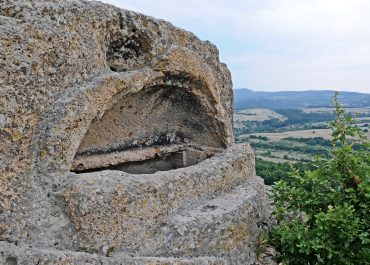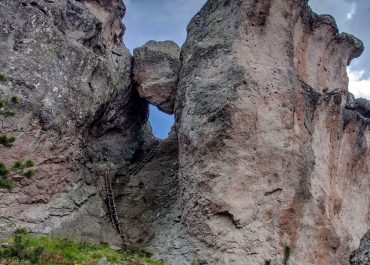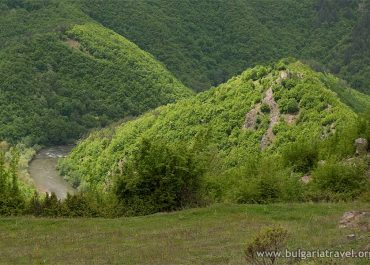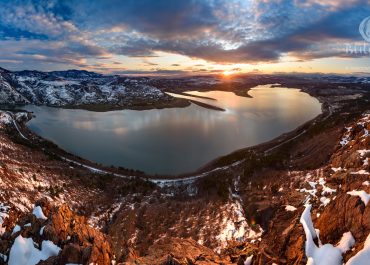
Vishegrad
It is located in the area of Hasar Yustu, on the right bank of the Arda River in the area of the village of Vishegrad and is located on a characteristic rocky peak with steeply sloping rocks above the Studen Kladenets Dam. The fortress is small, 562 sq. m, and the preserved walls are up to 8 m high. It was probably built in the 4th century. The fortress lasted until the 14th century.
The name of the fortress is of Slavic origin and means “high city”, a name given to fortresses in other Slavic countries. The walls reuse the foundations of an earlier fortress built in antiquity. Among the local population it is known by the toponym Hisar Yustyu / Upper Fortress /. In plan and size, it is a typical feudal castle from the Middle Ages. According to the researchers and the toponym, the assumptions are that it was the residence of the regional governor of Ahridos. It is in direct connection with the large fortress Mneakos / Monyak / which is on the hill opposite.
Monyak Fortress is perched on the impenetrable slopes of the eponymous peak. It was the main fortification of the Bulgarian rulers at the beginning of the Bulgarian state in this area. From the Monyak fortress there is a fascinating panoramic view of the mountain, especially to the south, where huge precipices begin, reaching the shores of the Studen Kladenets dam. The medieval fortress of Vishegrad is among the most famous in the Rhodopes – it is often mentioned in the chronicles of Byzantine chroniclers. Located on a viewing peak above the Arda River, it controlled the main road passing from here.
(passes through the village of Gluhar)
NONE (whether there are guides, whether talks are held in other languages):
Guides can be hired from the Regional Historical Museum – Kardzhali *
* Upon prior request
It is recommended:
In summer, visitors should wear hats;
Stable shoes;
Water (at least 1,5l)
CULTURAL TOURIST INFORMATION CENTER – KARDZHALI
бул. Беломорски;
до Стадион „Арена Арда”
Monday – Friday: 09:00 – 17:00 h.
tел.: +359 361 22719
е-mail: info@kardjali-tourism.info
It is located in the area of Hasar Yustu, on the right bank of the Arda River in the area of the village of Vishegrad and is located on a characteristic rocky peak with steeply sloping rocks above the Studen Kladenets Dam. The fortress is small, 562 sq. m, and the preserved walls are up to 8 m high. It was probably built in the 4th century. The fortress lasted until the 14th century.
The name of the fortress is of Slavic origin and means “high city”, a name given to fortresses in other Slavic countries. The walls reuse the foundations of an earlier fortress built in antiquity. Among the local population it is known by the toponym Hisar Yustyu / Upper Fortress /. In plan and size, it is a typical feudal castle from the Middle Ages. According to the researchers and the toponym, the assumptions are that it was the residence of the regional governor of Ahridos. It is in direct connection with the large fortress Mneakos / Monyak / which is on the hill opposite.
Monyak Fortress is perched on the impenetrable slopes of the eponymous peak. It was the main fortification of the Bulgarian rulers at the beginning of the Bulgarian state in this area. From the Monyak fortress there is a fascinating panoramic view of the mountain, especially to the south, where huge precipices begin, reaching the shores of the Studen Kladenets dam. The medieval fortress of Vishegrad is among the most famous in the Rhodopes – it is often mentioned in the chronicles of Byzantine chroniclers. Located on a viewing peak above the Arda River, it controlled the main road passing from here.
(passes through the village of Gluhar)
NONE (whether there are guides, whether talks are held in other languages):
Guides can be hired from the Regional Historical Museum – Kardzhali *
* Upon prior request
It is recommended:
In summer, visitors should wear hats;
Stable shoes;
Water (at least 1,5l)
CULTURAL TOURIST INFORMATION CENTER – KARDZHALI
бул. Беломорски;
до Стадион „Арена Арда”
Monday – Friday: 09:00 – 17:00 h.
tел.: +359 361 22719
е-mail: info@kardjali-tourism.info
Virtual map
Photos
© All images, advertising and video materials and/or other information published on this website are property of the Ministry of Tourism and are protected by the Law on Copyright and Related Rights, according to the Bulgarian laws to all applicable international and relevant acts of the European Union.





